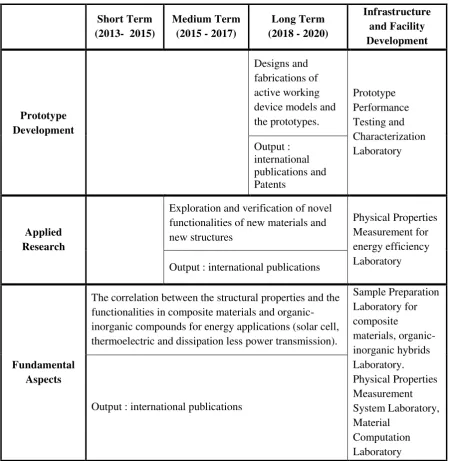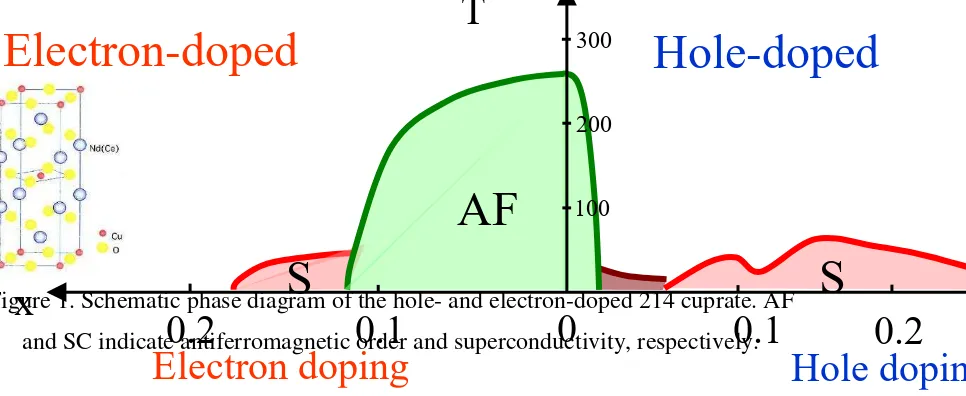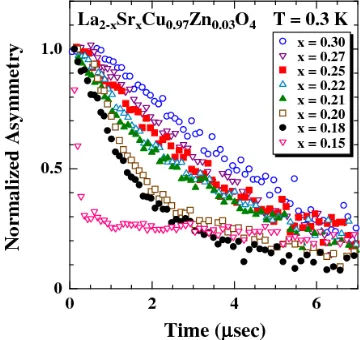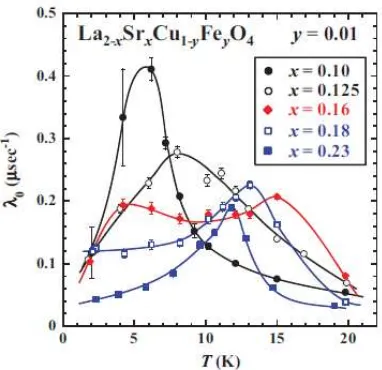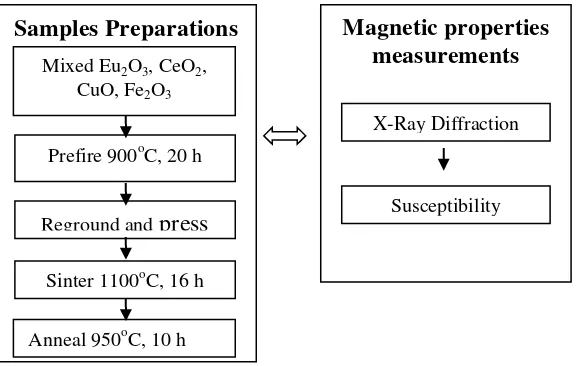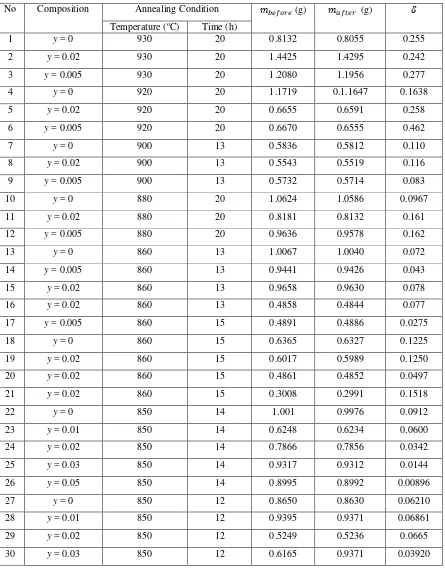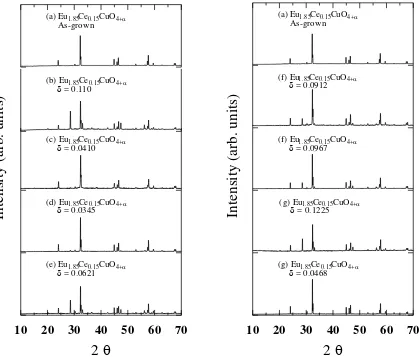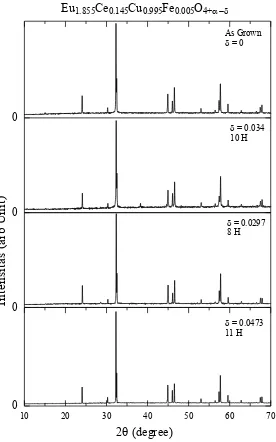LAPORAN AKHIR
INTERNATIONAL RESEARCH COLLABORATION
AND SCIENTIFIC PUBLICATION
STUDY OF Fe-INDUCED MAGNETIC STATE IN
ELECTRON-DOPED HIGH-T
cSUPERCONDUCTING
CUPRATES Eu
2-xCe
xCu
1-yFe
yO
4Tahun ke-1 dari rencana 2 tahun
Ketua/Anggota Tim
Dr. Risdiana, M. Eng.
NIDN: 0005057501
Dr. Togar Saragi, M. Si.
NIDN: 0026086803
Drs. Wahyu Alamsyah Somantri, MS.
NIDN: 0015115202
Sesuai dengan Keputusan DP2M DIKTI tentang Penetapan Penerima Penelitian, Pengabdian kepada Masyarakat dan Program Kreativitas Mahasiswa
Nomor : 0263/E5/2014 tanggal 24 Januari 2014
UNIVERSITAS PADJADJARAN
FINAL REPORT
INTERNATIONAL RESEARCH COLLABORATION
AND SCIENTIFIC PUBLICATION
STUDY OF Fe-INDUCED MAGNETIC STATE IN
ELECTRON-DOPED HIGH-T
cSUPERCONDUCTING
CUPRATES Eu
2-xCe
xCu
1-yFe
yO
4First Year For Two Years Research Project
RESEARCH TEAM
Dr. Risdiana, M. Eng.
NIDN: 0005057501
Dr. Togar Saragi, M. Si.
NIDN: 0026086803
Drs. Wahyu Alamsyah Somantri, MS.
NIDN: 0015115202
Sesuai dengan Keputusan DP2M DIKTI tentang Penetapan Penerima Penelitian, Pengabdian kepada Masyarakat dan Program Kreativitas Mahasiswa
Nomor : 0263/E5/2014 tanggal 24 Januari 2014
UNIVERSITAS PADJADJARAN
SUMMARY
Superconductor is a material that has zero electrical resistivity when they are cooled down to sufficiently low temperatures. Superconductor is a promising material for future applications especially for energy saving such as for superconductor cable without any energy loss of electric power transmission and high performance power storage devices. However, the mechanism describing the role of physical properties in superconductor is still far from being understood clearly. The main purpose of this proposal is to elucidate the hole-electron doping symmetry in the high-Tc cuprates and
to find the key phenomena for explaining the appearance of high-Tc superconductivity.
The studies of physical properties through the partially substitution of impurities for Cu in both systems are one of important ways to elucidate the electron-hole doping symmetry. Different with hole-doped superconductor, to our knowledge, however, no one has reported the effects of magnetic impurities Fe on the Cu-spin dynamics in the electron-doped cuprates so that clear conclusion of the relation between the dynamical stripe correlations and superconductivity in the electron-doped cuprates has not yet been obtained. Here, crystal growth and study the effect of partially substitution of magnetic impurity Fe for Cu to the magnetic properties in electron-doped superconducting cuprates of Eu2-x+yCex-yCu1-yFeyO4+-with x = 0.15 and y = 0, 0.005,
0.010, 0.020, 0.030, 0.050 have been investigated in order to clarify electron-hole doping symmetry in high Tc superconductors. Samples with various δ valus are
prepared by solid state reaction method. XRD data show that all samples have high quality samples for δ valus in the range between 0 – 0.09. The magnetic dc-susceptibility measurements show superconductivity with Tc onset about 15 K and 10
K, respectively for y = 0 and 0.005. Tc decreases with decreasing Fe and disappear for
y larger than 0.02 and 0.05. It is indicating that impurity Fe successfully disturbing spin-spin correlation in Cu layer. Volume fraction of the superconducting state (VSC)
decreases markedly from 100 % to 30 % with only 0.5 % impurity substitution. VSC is
completely zero when the concentration of Fe is larger than 2 %. From these results, it is found that partially substitution of magnetic impurity Fe for Cu effectively decreased superconducting properties of electron-doped superconductor Eu2-x+yCe x-yCu1-yFeyO4+α-δ.
Keywords: Electron-doped superconducting cuprates, Fe impurities, DC magnetic-susceptibility.
PREFACE
We would like to thanks to DIKTI, LPPM Universitas Padjadjaran, Dean of Faculty of Mathematics and Natural Sciences Universitas Padjadjaran, and head of Department of Physics Universitas Padjadjaran, who supported our research with title “Study Of Fe-Induced Magnetic State In Electron-Doped High-Tc Superconducting
Cuprates Eu2-xCexCu1-yFeyO4”.
These researches also based on research collaboration with Tohoku University and RIKEN, Japan and became one part of research theme in the road map of research collaboration on the basis scheme of MoU between four Universities (UNPAD, ITB, ITS, UGM) and RIKEN Nishina Center, Japan. We hope this project will give the opportunity for undergoing of undergraduate student to take final project related to this field.
Jatinangor, October 28, 2014
Research team
CONTENT
LEMBAR PENGESAHAN i
SUMMARY ii
PREFACE iii
CONTENT iv
LIST OF TABLE LIST OF FIGURE LIST OF APPENDIX
CHAPTER I INTRODUCTION 2
1.1 Background 2
1.2 Objective 3
1.3 Output 4
CHAPTER II LITERATURE STUDY 6
CHAPTER III RESEARCH OBJECTIVE AND ADVANTAGES 9
CHAPTER IV RESEARCH METODOLOGY 13
CHAVTER V RESULTS 13
CHAVTER VI RESEARCH PLANNING 13
CHAVTER VII CONCLUSSION
REFFERENCES 14
APPENDIX 1 JUSTIFICATION OF RESEARCH BUDGET 16
APPENDIX 2 SUPPORTING FACILITIES 19
APPENDIX 3 RESEARCH TEAM AND CONTRIBUTIONS 20
APPENDIX 4 LETTER OF AGGREEMENT FOR RESEARCH
COLLABORATION
21
APPENDIX 5 CURRICULUM VITAE 28
APPENDIX 6 SURAT PERNYATAAN KETUA PENELITI 43
LIST OF TABLE
Table 1. Roadmap for exploration of new materials for energy applications on the basis scheme of MoU between UNPAD, ITB, ITS, UGM and
RIKEN Nishina Center, Japan
5
Table 2. Annealing conditions and δ for various samples of Eu2-x+yCex-yCu
1-yFeyO4+α-δ
14
LIST OF FIGURE
Figure 1. Schematic phase diagram of the hole- and electron-doped 214 cuprate. AF and SC indicate antiferromagnetic order and superconductivity, respectively.
5
Figure 2 µZF-SR time spectra of hole-doped La2-xSrxCu0.97Zn0.03O4 with x
= 0.15 - 0.30 at 0.3 K (Risdiana et al., 2008).
7 Figure 3. Temperature dependence of the depolarization rate of the slowly
depolarizing component λ0 for typical values of x in
La2−xSrxCu1−yFeyO4 with y = 0.01 (Suzuki et al., 2012).
8
Figure 4. Diagram Block for research methodology 11
Figure 5. Raw materials of powders after mixed 12
Figure 6. Samples after annealing at 860 oC (a) and 900 oC (b) for 13 hours 12 Figure 7. XRD pattern of Eu2-x+yCex-yCu1-yFeyO4+α-δ with x = 0.15 and y = 0
at various δ values
15
Figure 8. XRD pattern of Eu2-x+yCex-yCu1-yFeyO4+α-δ with x = 0.15 and y =
0.005 at various δ values
16 Figure 9. XRD pattern of Eu2-x+yCex-yCu1-yFeyO4+α-δ with x = 0.15 and y =
0.01 at various δ values
17
Figure 10. XRD pattern of Eu2-x+yCex-yCu1-yFeyO4+α-δ with x = 0.15 and y =
0.02 at various δ values
17 Figure 11. XRD pattern of Eu2-x+yCex-yCu1-yFeyO4+α-δ with x = 0.15 and y =
0.03 at various δ values
18 Figure 12. XRD pattern of Eu2-x+yCex-yCu1-yFeyO4+α-δ with x = 0.15 and y =
0.05 at various δ values
18 Figure 13. Preparation of the powdered sample for DC magnetic-susceptibility
measurements
19 Figure 14. DC magnetic-susceptibility on zero-field cooling (ZFC) and field
cooling (FC) for Eu2-x+yCex-yCu1-yFeyO4+α-δ with with x = 0.15 and y
= 0, 0.005, 0.010, 0.020, 0.030 and 0.0050 at various δ values.
19
Figure 15. Fe concentration (y) dependence of superconductor volume fraction VSC for Eu2-x+yCex-yCu1-yFeyO4+α-δ
20
LIST OF APPENDIX
APPENDIX 1 SUPPORTING FACILITIES
APPENDIX 2 RESEARCH TEAM AND CONTRIBUTIONS APPENDIX 3 LIST OF PUBLICATION
APPENDIX 4 NUMBER OF INVOLVED STUDENTS
APPENDIX 5 FORMULIR EVALUASI ATAS CAPAIAN LUARAN KEGIATAN
1
CHAPTER I
INTRODUCTION
1.1 Background
Superconductor is a material that has zero electrical resistivity when they are cooled down to sufficiently low temperatures. Most of superconductors are cuprate compounds. One of their characteristics is that conducting planes of CuO2 are
included in their crystal structures and responsible for their electronic properties. When the CuO2 plane loses one electron because of doping, one mobile hole remains
in the CuO2 planes, leading to the formation of a hole-doped superconducting cuprate.
On the other hand, when the CuO2 plane gets an excess electron, superconductivity
realizes and forms an electron-doped superconducting cuprates. Superconductor is a promising material for future applications especially for energy saving such as for superconductor cable without any energy loss of electric power transmission and high performance power storage devices. However, the mechanism describing the role of physical properties in superconductor is still far from being understood clearly. The hole-electron doping symmetry in the high-Tc cuprates has been one of central
interests in relation to the mechanism of the high-Tc superconductivity. In order to
describe the mechanism of the high-Tc superconductivity, a stripe model of spins and
charges is suggested to be a probable one. Lots of studies have been carried out to clarify the relationship between stripes and superconductivity and the existence of stripe correlations of spins and charges have been established in hole-doped systems (Risdiana et al., 2008, Adachi et al., 2008). Especially, dynamically fluctuating stripes (dynamic stripes) have been theoretically suggested to play an important role for the appearance of superconductivity (Emery et.al., 1999). On the other hand, the stripe correlations have not yet been clearly observed in electron-doped systems even though the high-Tc superconductivity actually appears in the systems. Thus, from the
view point of the stripe model, the dynamic property of the electronic state of electron-doped systems is now recognized to be important to understand the role of stripes to the superconductivity. However, because of difficulties of sample preparations, the study of electron-doped systems has not been progressed so much and clear answer has not been achieved yet.
2
effect of Fe on the Cu-spin dynamics. it has been found that the magnetic transition temperature and magnetic correlation are enhanced through the 1% Fe substitution in a wide range of hole concentration where superconductivity appears in Fe-free La2−xSrxCuO4. Therefore, partially Fe substitution in electron-doped cuprates is
potential impurity to study the Cu-spin dynamics in the electron-doped system. To our knowledge, however, no one has reported the effects of magnetic impurities Fe on the Cu-spin dynamics in the electron-doped cuprates so that clear conclusion of the relation between the dynamical stripe correlations and superconductivity in the electron-doped cuprates has not yet been obtained. Here, we propose to growth high quality polycrystalline samples of electron-doped high-Tc superconducting cuprates
Eu2-xCexCu1-yFeyO4 to understand Fe-induced magnetic state in electron-doped high-Tc
superconducting cuprates. An advantage of this sample rather than other types of electron-doped systems is that the absence of rare earth moments such as Pr3+ moments in Pr1-xLaCexCuO4. Using Eu2-xCexCuO4 samples, we can directly observe
the dynamic behavior of Cu-spins and effects of impurity to them without any magnetic disturbance. Thus, this system would be a good candidate to achieve the answer to the objective of this proposed study. In any case, this proposed study will give us the important information of the mechanism of superconductivity based upon the dynamical stripe correlations in the high-Tc superconducting cuprates.
All samples of electron-doped high-Tc superconducting cuprates Eu2-x+yCe x-yCu1-yFeyO4 will be prepared in Padjadjaran University. On the other hand, in the first
year, Tohoku University will support all magnetic characterizations such as susceptibility measurements using SQUID magnetometer (Quantum Design, Model MPMS-XL5), and in the second year, The Physical and Chemical Research Institute (RIKEN), Japan will support all muon spin relaxation measurements using SR spectroscopy in RIKEN-Rutherford Appleton Laboratory (RAL) muon facility at Oxford, UK.
1.2 Objective
The main purpose of the proposed study is to elucidate whether the dynamic stripes are a key phenomena for the high-Tc superconductor or not and whether the
hole-electron doping symmetry is observed in the high-Tc superconductor or not. We
3
superconducting cuprates. In order to investigate the dynamic property of stripes, a pinning effect by impurities is a good way to be studied. Here, we chose Eu2-x+yCex-yCu1-yFeyO4 to understand Fe-induced magnetic state in
electron-doped high-Tc superconducting cuprates and to achieve the answer to
the objective of this proposed study.
1.3 Ouput
4
Table 1. Roadmap for exploration of new materials for energy applications on the basis scheme of MoU between UNPAD, ITB, ITS, UGM and RIKEN Nishina
Center, Japan.
Short Term (2013- 2015)
Medium Term (2015 - 2017)
Long Term (2018 - 2020)
Infrastructure and Facility Development Prototype Development Designs and fabrications of active working device models and the prototypes. Prototype Performance Testing and Characterization Laboratory Output : international publications and Patents Applied Research
Exploration and verification of novel functionalities of new materials and new structures
Physical Properties Measurement for energy efficiency Laboratory Output : international publications
Fundamental Aspects
The correlation between the structural properties and the functionalities in composite materials and organic-inorganic compounds for energy applications (solar cell, thermoelectric and dissipation less power transmission).
5
CHAPTER II
LITERATURE STUDY
Superconductor is a material showing a phenomenon that has zero electrical resistivity when they are cooled down to sufficiently low temperatures. The temperature at which the electrical resistivity starts to be zero is called the critical temperature (Tc). Because of this phenomenon, some applications are developed for
future technology especially for energy saving such as for superconductor cable without any energy loss of electric power transmission and high performance power storage devices.
Most of superconductors are cuprate compounds. These superconducting cuprates are often called high-Tc superconducting cuprates (HTSC). The era of
high-Tc superconducting cuprates began when Bednorz and Muller reported possible
superconductivity in single-layer cuprates called 214 cuprates (Bednorz et al., 1986). The parent compound of these cuprates is La2CuO4. Superconductivity appears by
randomly substituting some Sr atoms for La and forming La2-xSrxCuO4. When a La3+
ion is replaced by Sr2+, the CuO2 plane loses one electron so that one mobile hole
remains in the CuO2 planes, leading to the formation of a hole-doped cuprate. Another
family of single-layer cuprates is the electron-doped (Nd, Pr, Sm)-Ce-Cu-O. In these materials, when a Nd3+ or Pr3+ or Sm3+ is replaced by Ce4+, the CuO2 plane gets an
excess electron, leading to the formation of an electron-doped cuprates (Tokura et al., 1989). All of the crystals have common structures consist of both the conduction layer (CuO2 plane) and the charge reservoir layer. CuO2 planes are responsible for their
electronic properties.
Figure 1. Schematic phase diagram of the hole- and electron-doped 214 cuprate. AF and SC indicate antiferromagnetic order and superconductivity, respectively.
0.2
0.1
0
0.1
0.2
T
x
x
AF
S
S
Electron
-
doped
Hole
-
doped
Electron doping
Hole doping
0.3
6
The so-called hole-electron doping symmetry in the high-Tc cuprates has been
one of central interests in relation to the mechanism of the high-Tc superconductivity.
Phase diagrams of the hole- and electron-doped systems are very similar to each other. That is, the parent compounds are both Mott insulators exhibiting long-range antiferromagnetic order with similar values of the Neel temperature. The superconducting phases appear through doping holes or electrons into the Mott insulators as shown in Fig 1. These properties lead to the view of hole-electron doping symmetry. On the other hand, some properties in the electron-doped superconductors have been found to be different from those in the hole-doped superconductors, leading to the hole-electron doping asymmetry. First, the effectiveness of carriers for destroying the long-range antiferromagnetic order is different between the hole- and electron-doped systems. In the electron-doped system of Nd2-xCexCuO4, the
long-range antiferromagnetic order survives up to x ~ 0.13 (Takagi et al., 1989), while it survives only up to x ~ 0.02 in the hole-doped system of La2-xSrxCuO4.
Secondly, in the inelastic neutron-scattering measurements, an incommensurate spin-correlation, which may be due to the so-called dynamically fluctuating stripes of spins and holes (Tranquada et al., 1995), has been found in the hole-doped system (Yamada et al., 1998). In the electron-doped system, on the other hand, a commensurate spin-correlation, which is related to the simple antiferromagnetic order, has been observed (Yamada et al., 2003).
Impurity-substitution effects to the some physical properties have been also intensively studied to understand the role and mechanism of superconductivity. Different behaviors between the hole- and electron-doped systems are also observed. For examples, the superconductivity in the electron-doped system is suppressed through the substitution of magnetic Ni for Cu more markedly than through the substitution of nonmagnetic Zn for Cu (Tarascon et al., 1990), which is contrary to the result in the hole-doped system (Xiao et al., 1990).
From the view of the Cu-spin dynamics properties, one of important phenomena in the 214 cuprates is that in hole-doped system, charge in the CuO2 plane
7
tetragonal low-temperature structure (space group: P42/ncm), leading to the static
stabilization and suppression of superconductivity at p = 1/8. These results can be well described using the stripe model. This model consists of hole (charge) domains and spin domains. Charge stripes refer to a charge density wave (CDW) and spin stripes refer to a spin density wave (SDW). From ZF-SR measurements, it has been found that a slight amount of Zn tends to induce slowing down of the Cu-spin fluctuations in the whole superconducting regime of hole-doped system, which is able to be interpreted as being due to pinning and stabilization of the dynamically fluctuating stripes of spins and holes (Risdiana et al., 2008, Adachi et al., 2008).
Figure 2.ZF-SR time spectra of hole-doped La2-xSrxCu0.97Zn0.03O4 with x = 0.15 -
0.30 at 0.3 K (Risdiana et al., 2008).
Figure 2 shows the ZF-SR time spectra at 0.3 K for La2-xSrxCu0.97Zn0.03O4 with x
= 0.15 - 0.30 (Risdiana et al., 2008). The muon-spin depolarization becomes weak with increasing x but still shows an exponential-like depolarization at x = 0.27. The exponential-like depolarization disappears at x = 0.30 where the superconductivity also disappears in the Zn-free y = 0. Therefore, these results suggest that the pinning of the dynamically fluctuating stripes occurs in the overdoped regime as well, that is, the stripe-pinning model holds good even for overdoped La2-xSrxCuO4. This result
might point to the importance of the dynamical stripe correlations in the appearance of high-Tc superconductivity in the hole-doped system (Emery et al., 1999).
For Fe substitution samples of La2-xSrxCu1-yFeyO4, it has been found that the magnetic
8
Figure 3.Temperature dependence of the depolarization rate of the slowly depolarizing component λ0 for typical values of x in La2−xSrxCu1−yFeyO4 with y = 0.01
(Suzuki et al., 2012).
Figure 3 show the temperature dependence of the depolarization rate of the slowly depolarizing component λ0 for typical values of x in La2−xSrxCu1−yFeyO4 with y
= 0.01 (Suzuki et al., 2012). It appears that two peaks of λ0 observed in x = 0.16
originate from the stripe order of Cu spins at low temperatures below ~ 4 K and from the spin-glass state of Fe spins at temperatures below ~ 15 K. Therefore, it is guessed that the two magnetic state change with changing hole doping.
In other hand, the mechanism of superconductivity in the electron-doped high-Tc cuprates has not yet been clarified also. It is of great interest whether the
stripe-pinning model holds good even for the electron-doped system or not and whether the mechanism in the electron-doped high- Tc cuprates is different from that in the
hole-doped ones or not. We measured the ZF-SR time spectra of Pr0.86LaCe0.14Cu 1-yZnyO4+- with y = 0, 0.01, 0.02, 0.05 and large values (Risdiana et al., 2010). It is
found that the spectra are independent of the Zn concentration, meaning that no impurity-induced slowing down of the Cu-spin fluctuations is detected in electron-doped Pr0.86LaCe0.14CuO4+-. That is, Zn impurities do not appear to affect the
Cu-spin dynamics, which is very different from the results of hole-doped La2-xSrxCu 1-yZnyO4 as shown in Fig. 2. This may be understood in two ways. First, there may be
9
be conclusive, another electron-doped cuprate without Pr3+ moments such as Eu 2-xCexCuO4 should be used for this study. An advantage of this sample rather than other
types of electron-doped systems is that the absence of rare earth moments such as Pr3+ moments in Pr1-xLaCexCuO4. Using Eu2-xCexCuO4 samples, we can directly observe
the dynamic behavior of Cu-spins and effects of impurity to them without any magnetic disturbance. Thus, this system would be a good candidate to achieve the answer to the objective of this proposed study.
10
CHAPTER III
RESEARCH OBJECTIVE AND ADVANTAGES
3.1 Objective
The main purpose of this research is to elucidate whether the dynamic stripes are a key phenomena for the high-Tc superconductor or not and whether the
hole-electron doping symmetry is observed in the high-Tc superconductor or not. We aim
to clarify the dynamic property of magnetic state in electron-doped high-Tc
superconducting cuprates. In order to investigate the dynamic property of stripes, a pinning effect by impurities is a good way to be studied. Here, we chose Eu2-x+yCe x-yCu1-yFeyO4 to understand Fe-induced magnetic state in electron-doped high-Tc
superconducting cuprates and to achieve the answer to the objective of this research.
3.2 Advantages
The advantages of this research are listed below.
a. These studies will be useful for comparison with our previous study in electron-doped Pr1-xLaCexCu1-yZnyO4 and hole-doped La2-xSrxCu1-yFeyO4 to find the key
phenomena for explaining the appearance of high-Tc superconductivity in the
point of view spin dynamics properties.
b. Understanding the physical theory about phenomena for the high-Tc
superconductor especially about the hole-electron doping symmetry.
c. After finishing this research program, we will be able to prepare one international publication every year (two international publications in total for two year)
11
CHAPTER IV
RESEARCH METHODOLOGY
The method of our research is experimental research described in Figure 4.
Figure 4. Diagram Block for research methodology
Figure 4 shows the research methodology of our proposal. First part is samples preparations. Polycrystalline samples of Eu2-x+yCex-yCu1-yFeyO4 (ECCFO) with x =
0.15 and y = 0, 0.005, 0.01, 0.02, 0.03 and 0.05 were prepared by the ordinary solid-state reaction method as follows. From April to July 2014, we prepared Polycrystalline samples of Eu2-x+yCex-yCu1-yFeyO4 (ECCFO) with x = 0.15 and y = 0,
0.005, and 0.02. Raw materials of Eu2O3, CeO2, CuO and Fe2O3 powders were mixed
in a stoichiometric ratio and prefired in air at 900oC for 20 h. The prefired materials are reground and pressed into pellets of 10 mm in diameter, and sintered in air at 1000oC for 16 h with repeated regrinding. As-grown samples of ECCFO, are annealed in flowing Ar gas of high purity (6N) at various temperature between 950oC for 10 h in order to remove the excess oxygen at the apical site. All samples preparations will be doing in Unpad. Second part is checking quality and measuring magnetic properties of the samples such as XRD, resistivity and DC magnetic-susceptibility measurements that carried out at low temperatures down to 2 K using a standard SQUID magnetometer (Quantum Design, Model MPMS-XL5) in a magnetic field of 5 Oe on field cooling. All the second parts have been doing in Koike Laboratory at Tohoku University and at the Rutherford-Appleton Laboratory in the UK.
Samples Preparations Magnetic properties measurements
Mixed Eu2O3, CeO2,
CuO, Fe2O3
Prefire 900oC, 20 h
Reground and press
Sinter 1100oC, 16 h
Anneal 950oC, 10 h
X-Ray Diffraction
12
CHAPTER V
RESULTS
5.1 Crystal Growth
Polycrystalline samples of Eu2-x+yCex-yCu1-yFeyO4 with x = 0.15 and y = 0,
0.005, 0.010, 0.020, 0.030 and 0.050 were prepared by the ordinary solid-state reaction method. Raw materials of powders were mixed in a stoichiometric ratio and prefired in air at 900oC for 20 h. Figure 5 shows raw materials of powders after mixed in stoichiometric ratio. The grey color of raw materials after mixed is observed.
Figure 5. Raw materials of powders after mixed
The prefired materials are reground and pressed into pellets of 10 mm in diameter, and sintered in air at 1000oC for 16 h with repeated regrinding. The samples after sintering are called As-grown samples of ECCFO. As-grown samples of ECCFO are annealed in flowing Ar gas of high purity (6N) at various temperatures in between 820 to 930oC for 8 to 20 h in order to remove the excess oxygen at the apical site. The reduced oxygen content δ was estimated from the weight change before and after annealing. Figure 6 shows samples after annealing at 860 oC (a) and 900 oC (b) for 13 hours.
Figure 6.Samples after annealing at 860 oC (a) and 900 oC (b) for 13 hours
13
Table 2 shows the summary of annealing conditions and delta (δ) after calculated using equations
. The values of δ are varying between
0.00896 and 0.462. The annealing processes can be reduced oxygen contents. However, the value of δ cannot be controlled well.
Table 2. Annealing conditions and δ for various samples of Eu2-x+yCex-yCu1-yFeyO4+α-δ
No Composition Annealing Condition (g) (g)
Temperature (oC) Time (h)
1 y = 0 930 20 0.8132 0.8055 0.255
2 y = 0.02 930 20 1.4425 1.4295 0.242
3 y = 0.005 930 20 1.2080 1.1956 0.277
4 y = 0 920 20 1.1719 0.1.1647 0.1638
5 y = 0.02 920 20 0.6655 0.6591 0.258
6 y = 0.005 920 20 0.6670 0.6555 0.462
7 y = 0 900 13 0.5836 0.5812 0.110
8 y = 0.02 900 13 0.5543 0.5519 0.116
9 y = 0.005 900 13 0.5732 0.5714 0.083
10 y = 0 880 20 1.0624 1.0586 0.0967
11 y = 0.02 880 20 0.8181 0.8132 0.161
12 y = 0.005 880 20 0.9636 0.9578 0.162
13 y = 0 860 13 1.0067 1.0040 0.072
14 y = 0.005 860 13 0.9441 0.9426 0.043
15 y = 0.02 860 13 0.9658 0.9630 0.078
16 y = 0.02 860 13 0.4858 0.4844 0.077
17 y = 0.005 860 15 0.4891 0.4886 0.0275
18 y = 0 860 15 0.6365 0.6327 0.1225
19 y = 0.02 860 15 0.6017 0.5989 0.1250
20 y = 0.02 860 15 0.4861 0.4852 0.0497
21 y = 0.02 860 15 0.3008 0.2991 0.1518
22 y = 0 850 14 1.001 0.9976 0.0912
23 y = 0.01 850 14 0.6248 0.6234 0.0600
24 y = 0.02 850 14 0.7866 0.7856 0.0342
25 y = 0.03 850 14 0.9317 0.9312 0.0144
26 y = 0.05 850 14 0.8995 0.8992 0.00896
27 y = 0 850 12 0.8650 0.8630 0.06210
28 y = 0.01 850 12 0.9395 0.9371 0.06861
29 y = 0.02 850 12 0.5249 0.5236 0.0665
14
No Composition Annealing Condition (g) (g)
Temperature (oC) Time (h)
31 y = 0.05 850 12 0.8650 0.8630 0.00986
32 y = 0 820 14 0.7712 0.7704 0.0279
33 y = 0.005 820 14 1.1412 1.1402 0.0235
34 y = 0.01 820 14 0.5933 0.5924 0.0407
35 y = 0.02 820 14 1.1744 1.1733 0.0252
36 y = 0.03 820 14 1.0824 1.0814 0.0248
37 y = 0.05 820 14 0.9253 0.9249 0.0116
38 y = 0 850 8 0.9348 0.9336 0.0345
39 y = 0.005 850 8 1.1746 1.1733 0.0297
40 y = 0.01 850 8 1.3799 1.3786 0.0253
41 y = 0.02 850 8 0.9726 0.9717 0.0249
42 y = 0.03 850 8 1.0635 1.0628 0.0117
43 y = 0.05 850 8 1.0147 1.0137 0.0265
44 y = 0 830 10 0.4868 0.4868 0
45 y = 0.005 830 10 0.6243 0.6237 0.0260
46 y = 0.01 830 10 0.7278 0.7274 0.0150
47 y = 0.02 830 10 0.9133 0.9126 0.0206
48 y = 0.03 830 10 0.7211 0.7205 0.0224
49 y = 0.05 830 10 0.6632 0.6632 0
50 y = 0 850 10 0.3221 0.3216 0.041
51 y = 0.005 850 10 0.5445 0.5938 0.034
52 y = 0.01 850 10 0.7499 0.7492 0.025
53 y = 0.02 850 10 0.6542 0.6535 0.028
54 y = 0.03 850 10 0.6407 0.6403 0.016
55 y = 0.05 850 10 0.7595 0.7592 0.01
56 y = 0 850 11 0.2296 0.2292 0.0468
57 y = 0.005 850 11 0.4542 0.4534 0.0473
58 y = 0.01 850 11 0.2479 0.2475 0.0433
59 y = 0.02 850 11 0.1028 0.1026 0.0523
60 y = 0.03 850 11 0.4769 0.4764 0.0282
61 y = 0.05 850 11 0.5679 0.5677 0.0090
15
5.2 XRD Measurement
All of the samples were characterized through the powder X-ray diffraction (XRD) using X-Ray Bruker D8 Advance.
Figure 7 shows XRD pattern of Eu2-x+yCex-yCu1-yFeyO4+α-δ with x = 0.15 and y
= 0 at various δ values. All main peaks of ECCO are shown in the spectra indicating high qualities of samples are formed for δ values smaller than 0.09. For δ values larger than 0.09, some impurities peaks are observed due to de -composition of samples because of over-reduction of oxygen.
Figure 7. XRD pattern of Eu2-x+yCex-yCu1-yFeyO4+α-δ with x = 0.15 and y = 0 at various
δ values
Figure 8 shows XRD pattern of Eu2-x+yCex-yCu1-yFeyO4+α-δ with x = 0.15 and y = 0.005
at various δ values. There is no unexpected peak in all spectra indicating high qualities of samples in the range
(a) Eu1.85Ce0.15CuO4+
As-grown
Int
e
ns
it
y (a
rb. uni
ts
)
(c) Eu1.85Ce0.15CuO4+
= 0.0410
(a) Eu1.85Ce0.15CuO4+
As-grown
(d) Eu1.85Ce0.15CuO4+
= 0.0345
10 20 30 40 50 60 70
(e) Eu1.85Ce0.15CuO4+
= 0.0621
2
(b) Eu1.85Ce0.15CuO4+ = 0.110
(f) Eu1.85Ce0.15CuO4+
= 0.0912
(f) Eu1.85Ce0.15CuO4+
= 0.0967
Int
e
ns
it
y (a
rb. uni
ts
)
(g) Eu1.85Ce0.15CuO4+
= 0.1225
10 20 30 40 50 60 70
2
(g) Eu1.85Ce0.15CuO4+16
Figure 8. XRD pattern of Eu2-x+yCex-yCu1-yFeyO4+α-δ with x = 0.15 and y = 0.005 at
various δ values
Figures 9, 10, 11, 12 show pattern of Eu2-x+yCex-yCu1-yFeyO4+α-δ with x = 0.15 and y =
0.01, 0.02, 0.03 and 0.05 at various δ values, respectively. Generally, with increasing Fe concentration, unexpected peaks are observed even in the lower δ values below 0.09. We assumed that substitution of Fe affected to the de-composition of samples during oxygen reduction.
0
= 0.034 10 H
Eu
1.855Ce
0.145Cu
0.995Fe
0.005O
4+0
= 0.0297 8 H
10 20 30 40 50 60 70
0
= 0.0473 11 H
2
(degree)
Int
e
ns
it
a
s (
a
rb U
ni
t)
0
As Grown
17
Figure 9. XRD pattern of Eu2-x+yCex-yCu1-yFeyO4+α-δ with x = 0.15 and y = 0.01 at
various δ values
Figure 10. XRD pattern of Eu2-x+yCex-yCu1-yFeyO4+α-δ with x = 0.15 and y = 0.02 at
various δ values
0
Eu1.86Ce0.14Cu0.99Fe0.01O4+
= 0.0253 8 H
0
= 0.0252 10 H
0
= 0.0407 11 H
10 20 30 40 50 60 70
0
= 0.06861 12 H
2 (degree)
Int ent si ta s ( ar b U ni t) 0 As Grown = 0 Eu1.87Ce0.13Cu0.98Fe0.02O4+
10 20 30 40 50 60 70 0
= 0.0665 12 H
2 (degree)
18
Figure 11. XRD pattern of Eu2-x+yCex-yCu1-yFeyO4+α-δ with x = 0.15 and y = 0.03 at
various δ values
Figure 12. XRD pattern of Eu2-x+yCex-yCu1-yFeyO4+α-δ with x = 0.15 and y = 0.05 at
various δ values
0
= 0.0177 8 H
Eu1.88Ce0.12Cu0.98Fe0.03O4+
Int ens it as ( ar b. U ni t)
10 20 30 40 50 60 70
0
= 0.0392 12 H
2 (degree)
0
As Grown = 0
0
= 0.0265
8 H
Eu1.9Ce0.1Cu0.95Fe0.05O4+
10 20 30 40 50 60 70
0
= 0.0986
12 H
2 (degree) 0
As Grown
= 0
0
= 0.01
19
5.3 DC Magnetic-Susceptibility
DC magnetic-susceptibility measurements were carried out at low temperatures down to 2 K using a standard SQUID magnetometer (Quantum Design, Model MPMS-XL5) in a magnetic field of 5 Oe on field cooling. A sintered pellet of the polycrystalline sample was pulverized to be powdered. The powdered sample with 50-80 mg in weight was covered with parafilm and inserted into a plastic tube as shown in Figure 13.
Figure 13. Preparation of the powdered sample for DC magnetic-susceptibility measurements
Figure 14. DC magnetic-susceptibility on zero-field cooling (ZFC) and field cooling (FC) for Eu2-x+yCex-yCu1-yFeyO4+α-δ with with x = 0.15 and y = 0, 0.005, 0.010, 0.020,
0.030 and 0.0050 at various δ values.
0
10
20
30
-6
-4
-2
0
Eu
1,85+yCe
0.15-yCu
1-yFe
yO
4+
(1
0
-4
em
u/
gr
)
y = 0 , = 0.0621
y = 0.005 , = 0.02745
y = 0.010 , = 0.0252
y = 0.020 , = 0.0665
y = 0.030 , = 0.0392
y = 0.050 , = 0.0896
T (K)
20
Figure 14 shows temperature dependence of dc magnetic-susceptibility on field cooling at 5 Oe for Eu1.85+yCe0.15-yCu1-yFeyO4+- with y = 0 - 0.050 and values from
0.0252 to 0.0896. For impurity-free samples of y = 0, diamagnetic behavior with smaller than 0 is observed starting from about 15 K. This temperature can be defined as Tc onset for this sample. For y = 0.005, Tc onset decreases to be around 10 K. The
trace of superconductivity disappeared at y 0.020. It is indicating that impurity Fe successfully disturbing spin-spin correlation in Cu layer in electron-doped superconducting cuprates.
The volume fraction of the superconducting state, VSC, has been estimated from
the absolute value of at 2 K. The value of at 2 K of impurity-free samples is assumed as correspond to 100 % of VSC. The value of VSC for each
impurity-substituted sample is estimated using equation below :
.
χECCO is the value of at 2 K for impurity-free samples, χECCFO is the value of at 2 K
for Eu2-x+yCex-yCu1-yFeyO4+α-δ..
Figure 15. Fe concentration (y) dependence of superconductor volume fraction VSC
for Eu2-x+yCex-yCu1-yFeyO4+α-δ.
0
0.01
0.02
0.03
0.04
0.05
0
20
40
60
80
100
Eu
1,85+yCe
0.15-yCu
1-yFe
yO
4+V
SC
(%)
21
Figure 15 shows Fe concentration (y) dependence of volume fraction of the superconducting state (VSC). It is found that VSC decreases markedly from 100 % to
30 % with only 0.5 % impurity substitution. VSC is completely zero when the
concentration of Fe is larger than 2 %. From these results, it is found that partially substitution of magnetic impurity Fe for Cu effectively decreased superconducting properties of electron-doped superconductor Eu2-x+yCex-yCu1-yFeyO4+α-δ.
22
CHAPTER VI
RESEARCH PLANNING
In the second year, crystal growth with optimization growth condition, XRD and µSR measurementswill be performed.
6.1 Crystal Growth
Polycrystalline samples of Eu2-x+yCex-yCu1-yFeyO4 (ECCFO) with x = 0.15 and y = 0,
0.005, 0.01, 0.02, 0.03 and 0.05 will be completely prepared by the ordinary solid-state reaction method. Annealing condition will be optimized to get high quality samples with best δ values in between 0.03 and 0.09. For these purposes, variation of temperatures and times will be needed. The annealing will be performed in Ar gas flow with temperature between 850 oC and 830 oC for 14, 12 and 10 h.
6.2 XRD Measurements
All of the samples after annealing will be characterized by the powder X-ray diffraction (XRD) at Tohoku University.
6.3 µSR measurements
23
24
CHAPTER VII
CONCLUSION
Eelectron-doped high-Tc superconducting cuprates of Eu2-x+yCex-yCu1-yFeyO4+α-δ
(ECCFO) with x = 0.15 and y = 0, 0.005, 0.01, 0.02, 0.03 and 0.05 have been prepared in order to investigate the effects of Fe impurities to the magnetic properties in the electron-doped system. Various annealing conditions resulted samples with δ values varying between 0.00896 and 0.462. All of XRD data show that all samples have high quality when the sample has δ values smaller than that of 0.09. DC magnetic-susceptibility measurements of samples with x = 0.15, y = 0, 0.005 show superconductivity with Tc onset about 15 K and 10 K, respectively. The trace of
superconductivity disappeared at y 0.020. It is indicating that impurity Fe successfully disturbing spin-spin correlation in Cu layer in electron-doped superconducting cuprates.
Volume fraction of the superconducting state (VSC) decreases markedly from
100 % to 30 % with only 0.5 % impurity substitution. VSC is completely zero when
25
REFFERENCES
(Adachi et al., 2008) T. Adachi, N. Oki, Risdiana, S. Yairi, Y. Koike, I. Watanabe, 2008, “Effect of Zn and Ni substitution on the Cu-spin dynamics and superconductivity in La2-xSrxCu1-y(Zn,Ni)yO4
(x = 0.15-0.20): muon spin relaxation and magnetic susceptibility study”, Phys. Rev. B 78, 134515.
(Adachi et al.,2004) T. Adachi, S. Yairi, K. Takahashi, Y. Koike, I. Watanabe, K. Nagamine, 2004, “Muon spin relaxation and magnetic susceptibility studies of the effects of nonmagnetic impurities on the Cu spin dynamics and superconductivity in La2-xSrxCu1-yZnyO4 with x = 0.115”, Phys. Rev. B 69,
184507.
(Bednorz et al., 1986) J. G. Bednorz and K. A. Muller, 1986, “Possible highTc
superconductivity in the Ba−La−Cu−O system”, Phys. B 64, 189.
(Emery et.al., 1999) V. J. Emery, S. A. Kivelson, J. M. Tranquada, 1999, “Stripe phases in high-temperature superconductors”, Proc. Natl. Acad. Sci. 96, 8814.
(Koike et al., 1992) Y. Koike, A. Kakimoto, M. Mochida, H. Sato, T. Noji, M. Kato and Y. Saito, 1992, “Superconductivity and Electrical Resistivity in the T′-Phase Pr2-yLay-xCexCuO4-δ“, Jpn. : J.
Appl. Phys. 31, 2721.
(Risdiana et al., 2010) Risdiana, T. Adachi, N. Oki, Y. Koike, T. Suzuki, I.
Watanabe, 2010, “Muon-spin-relaxation study of the Cu -spin dynamics in electron-doped high-Tc superconductor Pr0.86LaCe0.14Cu1-yZnyO4”, Physical Review B 82, 014506.
(Risdiana et al., 2008) Risdiana, T. Adachi, N. Oki, S. Yairi, Y. Tanabe, K. Omori, T. Suzuki, I. Watanabe, A. Koda, W. Higemoto and Y. Koike, 2008, “Cu-spin dynamics in overdoped regime of La2-xSrxCu1-yZnyO4 probed by muon spin relaxation”, Phys.
Rev. B 77, 054516.
26
Nagamine, 2005, “Absence of the impurity-induced magnetic order in the electron-doped high-Tc cuprates
Pro.86LaCe0.14Cu1-y(Zn,Ni)yO4 “, Physica C 426-431, 355.
(Suzuki et al., 2012) K. M. Suzuki, T. Adachi, Y. Tanabe, H. Sato, Risdiana, Y. Ishii, T. Suzuki, I. Watanabe, Y. Koike, 2012, Distinct Fe -induced magnetic states in the underdoped and overdoped regimes of La2-xSrxCu1-yFeyO4 revealed by muon spin
relaxation, Physical Review B 86, 014522.
(Takagi et al., 1989) H. Takagi, S. Uchida, Y. Tokura, 1989,“Superconductivity produced by electron doping in CuO2-layered compounds”,
Phys. Rev. Lett 62, 1197.
(Tarascon et al., 1990) J. M. Tarascon, E. Wang, S. Kievelson, B. G. Bagley, G. W. Hull, R. Ramesh, 1990, “Magnetic versus nonmagnetic ion substitution effects on Tc in the La-Sr-Cu-O and
Nd-Ce-Cu-O systems”, Phys. Rev. B 42, 218.
(Tokura et al., 1989) Y. Tokura, H. Takagi, S. Uchida, 1989, “A superconducting copper oxide compound with electrons as the charge carriers”, Nature 337, 345.
(Tranquada et al., 1995) J. M. Tranquada, B. J. Sternlieb, J. D. Axe, Y. Nakamura, S. Uchida, 1995, “Evidence for stripe correlations of spins and holes in copper oxide superconductors”, Nature 375, 561. (Xiao et al., 1990) G. Xiao, M. Z. Cieplak, J. Q. Xiao, C. L. Chien, 1990,
“Magnetic pair-breaking effects: Moment formation and critical doping level in superconducting La1.85Sr0.15Cu1-xAxO4
systems (A=Fe,Co,Ni,Zn,Ga,Al)”, Phys. Rev. B 42, 8752. (Yamada et al., 2003) K. Yamada, K. Kurahashi, T. Uefuji, M. Fujita, S. Park, S.
H. Lee, Y. Endoh, 2003, “Commensurate Spin Dynamics in the Superconducting State of an Electron-Doped Cuprate Superconductor”, Phys. Rev. Lett 90, 137004.
27
APPENDIX 1
SUPPORTING FACILITIES
All samples of electron-doped high-Tc superconducting cuprates Eu 2-xCexCu1-yFeyO4 will be prepared in Padjadjaran University. We have two
furnaces that needed for growing high-Tc superconducting cuprates. Tohoku
University will support all magnetic characterizations such as susceptibility measurements using SQUID magnetometer (Quantum Design, Model MPMS-XL5), and The Physical and Chemical Research Institute (RIKEN), Japan will support all muon spin relaxation measurements using SR spectroscopy in RIKEN-Rutherford Appleton Laboratory (RAL) muon facility at Oxford, UK.
28
RESEARCH TEAM AND CONTRIBUTIONS
No Name/NIDN Institution Research
Field
Research Period (hours/week)
Contributions
1 Dr. Risdiana, M. Eng. /0005057501
UNPAD Material
Science
15 Research designing, Crystal growth, results analysis, report
2 Dr. Togar Saragi, M.Si. /0026086803
UNPAD Material
Science
13 Crystal growth, Characterization, results analysis, report
3 Drs. Wahyu Alamsyah Sumantri,MS /0015115202
UNPAD Material
Science
29
SUPPORTING FACILITIES
RESEARCH TEAM AND CONTRIBUTIONS
LIST OF PUBLICATION
NUMBER OF INVOLVED STUDENTS
